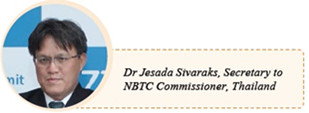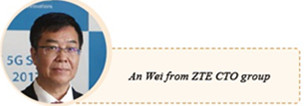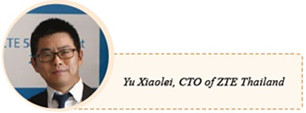Thailand Gearing up for 5G
Thailand is prepared to usher in the new telecommunications era of 5G as the country moves to Thailand 4.0, a new economic model based on new technology and innovation. During the ZTE 5G Summit held in Thailand in November 2017, representatives from the mobile operator True, the regulatory body NBTC and the telecom vendor ZTE talked about the challenges and opportunities arising with the 5G era. As a 5G pioneer, ZTE organized this summit to promote cooperation across the 5G industry chain and boost Thailand’s 5G development.
What do you think is ZTE’s role in future 5G development?

Adisak Prasongsup: For ZTE there are currently 3G, 4G and even 4.5G network rollout which True thinks is pretty up-to-date technology. In terms of 4.5G Massive MIMO project, this is the opportunity for ZTE to continue the 5G service. We hope that 5G technology from ZTE will solve the network problems and keep up to date with service usage. 5G will need more investment in terms of R&D for building a strong network. ZTE technology should be able to support the network capability in the future in both the IoT, which has to be developed continuously, and the smart city and smart home, which are the main interests of the market at the moment. 5G technology will be needed even more in the future when all smart devices become widely used.
What’s True’s plan for 5G development in the coming few years?
Adisak Prasongsup: For True, we definitely have a plan to support 5G. Now we are prepared with our 4.5G network. We also have networks covering up to 90% of the country. Therefore, True is ready to install 5G services in all the targeted areas which include metropolitan areas or all other big cities. In the coming future, all the operators will have to be ready to provide 5G services.
Could you review the developments of the mobile telecommunications market in Thailand?

Jesada Sivaraks: In Thailand, after we had set up the NBTC, we opened the first bidding in 2012. The market started to become more competitive and developed continuously. The big operators in Thailand have also upgraded their networks to 3G. Following this, there are biddings for 900 MHz, 1800 MHz and other developments. Right now we have 4G. For the next-generation technology which is 5G, we plan to set up and open new frequencies to increase competition in the market. We hope to see all operators strengthen their competitiveness.
How does the NBTC plan to accelerate the 5G development in Thailand?
Jesada Sivaraks: For Thailand, the NBTC has a technology-neutral policy. We support all new technology by releasing suitable frequency. For 5G development, we plan to increase the amount of spectrum available for 5G so that industry players can have sufficient frequencies to take our country to the 5G era.
How would you like ZTE to contribute to Thailand’s mobile market?
Jesada Sivaraks: In the 5G ecosystem, there is no buyer-seller relationship like that in 4G. In the future, operators and vendors need to cooperate further in order to develop the market capacity because there is going to be a series of new services and new industry players. There might not only be the mobile service provider and mobile service user, but the mobile service provider of 5G, other services providers and the service users in this new ecosystem.
How to develop Thailand into a leader of 5G technology in Asia-Pacific?

An Wei: 5G is the whole ecosystem which includes devices, spectrum, raido network, core network, transmission network and applications. If operators want to develop 5G, the first thing is to get the 5G spectrum. As a technology and network supplier, we provide 5G terminals, radio networks, transmission networks and core networks and we also support certain 5G applications. We also need to be open-minded and be ready to have close cooperation with all the verticals. We are ready to support Thailand as a leader in 5G technology in Asia-Pacific as part of Digital Thailand or Thailand 4.0.
What is the obstacle to open the 5G technology market in Thailand or other countries?
An Wei: The first one is to get the 5G spectrum. After you get the spectrum, we need to consider the two factors: 5G service demand and the return on investment. As the technology supplier, we must make sure that the terminals are ready, including not only the smartphones but also the IoT terminals; and the network is ready, including radio, transmission and core networks. The most critical parts are transmission ready for 5G and site acquisition as both of them take longer time. Optical fiber must be ready because there are lots of small cells in 5G network which need a lot of optical transmission.
Do we have any cooperation with any operators in Thailand?

Yu Xiaolei: For 3G and 4G, we have partnered with AIS and True. Currently, we are testing 5G technology Massive MIMO together with AIS and we are going to launch it with AIS. We also have the plan to conduct a 5G trial in 2018 in Thailand.
Which frequency is the most suitable for 5G?
An Wei: For 5G, there is middle band and high band. In middle band, there are two most popular spectrums. One is 3.5 GHz band used in Asia (including China) and Europe and the other is 4.7 GHz used in Japan and some other countries. For high band, there are two most popular ones: 28 GHz in US, Japan and Korea and 26 GHz in Asia (including China) and Europe.
Which frequency do we use with AIS?
Yu Xiaolei: Now we are testing 5G Massive MIMO in 1.8 GHz with AIS.
Thailand is going to have the bidding auction for 1.8 GHz in 2018. Do you think, if we use 1.8 GHz for 5G, is there going to be dropping or inefficiency in using this frequency?
An Wei: 5G will firstly focus on enhanced mobile broadband that requires wide bandwidth, like 100 MHz. This can only be available in the middle band and high band. By middle band, I’m talking about 3.5 GHz and 4.7 GHz and high band refers to 28 GHz or 26 GHz. 100 MHz bandwidth is not available in 1.8 GHz band for operators. 5G will start from the middle band and high band in the early 5G deployment stage. We will see frequency refarming, which includes 700 MHz, 900 MHz, and 1800 MHz in the later 5G deployment stage.
[Keywords] Thailand, 5G, True,